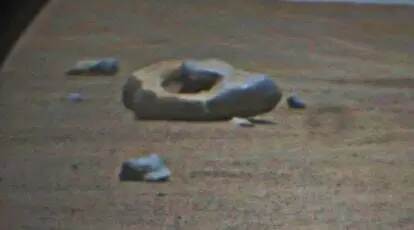
SETI Institute: NASA rover discovers strange donut-shaped rock on Mars
text_fieldsIn the United States, National Donut Day is observed on June 2, while it appears that the day is June 23 on Mars. That is when NASA's Perseverance Rover snapped a photo of a strange rock on Mars with a hole in the middle that resembled a doughnut.
The rock in the image might be a big meteorite surrounded by numerous smaller pieces, the SETI Institute suggested in a tweet on Monday. The Perseverance's SuperCam Remote Micro-Imager, according to the institution, took the photo on June 23, Indian Express reported.
Since the Perseverance Rover's arrival on Mars in 2021, it has found numerous prospective meteorite candidates, so that explanation is not improbable. Additionally, this is not the first time a rover or spacecraft has discovered unusually shaped rocks and other characteristics on the planet.
According to The Independent, scientists have found a structure on Mars that resembles a bear's face using the Mars Reconnaissance Orbiter. The bear's "eyes" were two craters in a rock formation, and the snout was a collapsed hill with a V-shape.
The iron-nickel meteorite recovered by the Curiosity Rover in February of this year was nicknamed "Cacao." The meteorite was roughly 30 centimetres in diameter.
At the western border of an open plain named Isisi Planitia, just north of the planet's equator, is the 45-kilometre-wide Jezero Crater, which Perseverance is now exploring. The distance between the landing sites of Curiosity and Perseverance is approximately 3,700 km.
Scientists say that the Jezero Crater formerly contained an old river delta and was completely covered by water. River channels may have spilt over the crater wall to form a lake more than 3.5 billion years ago. NASA claims that there is proof that water entered the crater lake carrying clay minerals from the surroundings.
However, Ingenuity Mars Helicopter, which is making brief flights around the planet in search of evidence that will tell scientists more about the planet, has joined Perseverance in the crater.























